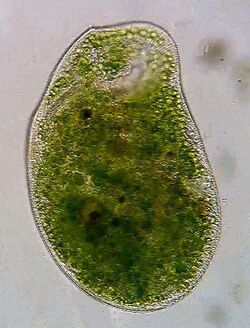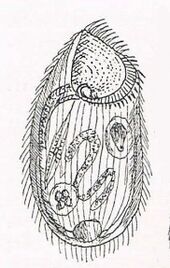Biology:Climacostomum virens
| Climacostomum virens | |
|---|---|

| |
| Climacostomum virens | |
| Scientific classification | |
| Domain: | Eukaryota
|
| (unranked): | |
| (unranked): | Alveolata
|
| Phylum: | Ciliophora
|
| Subphylum: | |
| Class: | Heterotrichea
|
| Order: | Heterotrichida
|
| Family: | Climacostomidae
|
| Genus: | |
| Species: | C. virens
|
| Binomial name | |
| Climacostomum virens (Ehrenberg, 1834) Stein, 1859
| |
Climacostomum virens is a species of unicellular ciliate protists. It is one of just two formally described species in the genus Climacostomum.
Description
Climacostomum virens has a flexible but non-contractile body, 100–300 micrometres (0.0039–0.0118 in) long, roughly ovoid or harp-shaped, and flattened from back to front. It has a large posterior contractile vacuole, and a characteristic posterior indentation, or dimple, that is more pronounced in underfed individuals.[1] The posterior vacuole surrounds the cytoproct (anus), through which food waste is eliminated.[2] The macronucleus of Climacostomum virens is normally long and wormlike (vermiform).[3]
The cell's most prominent feature is its large oral apparatus, which occupies most of the anterior region. This structure features an adoral zone of membranelles (AZM) partly encircling a wide buccal cavity (mouth), which opens into the cytopharyngeal pouch where digestive vacuoles are formed before they travel down a distinctive long, bent tube into the body of the cell.[2][4]
Members of the species are normally green, because of symbiotic algae (zoochlorellae) that live in the cytoplasm. When individuals are grown in the dark, these algal endosymbionts are reduced in number and the cytoplasm may appear colorless.[5]
Classification
The species Climacostomum virens was first described in 1833 by Christian Gottfried Ehrenberg, under the name Spirostomum virens. In 1859, Samuel Friedrich von Stein moved Spirostomum virens to a new genus, which he named Climacostomum. In his Manual of Infusoria (1880), William Saville-Kent rejected Stein's genus, assigning the species instead to Leucophrys patula, which he described as synonymous with Ehrenberg's Spirostomum virens and Leucophrys patula, as well as the Trichoda patula of O.F. Muller.[6] However, the genus was retained by later researchers, including Alfred Kahl.[3][7]
References
- ↑ Repak, Arthur J. (1972). "A Redescription of Climacostomum virens (Ehrenberg) Stein and Proposal of a New Heterotrich Ciliate Family, Climacostomidae fam. N". The Journal of Eukaryotic Microbiology 19 (3): 417–27. doi:10.1111/j.1550-7408.1972.tb03496.x.
- ↑ 2.0 2.1 Fischer-Defoy, Dorothee; Hausmann, Klaus (1982). "Ultrastructural characteristics of algal digestion by Climacostomum virens (Ciliata) (Ehrenberg) stein". Zoomorphology 100 (2): 121–30. doi:10.1007/BF00310358.
- ↑ 3.0 3.1 Carey, Philip G. (1992). Marine interstitial ciliates: an illustrated key. Chapman and Hall. p. 160. ISBN 978-0-412-40610-2.
- ↑ Kudo, Richard R. (1954). "Genus Climacostomum Stein". Protozoology (4th ed.). Springfield: Charles C. Thomas. p. 807. https://www.biodiversitylibrary.org/page/7235684.
- ↑ Peck, Robert; Pelvat, Bernard; Bolivar, Ignacio; Haller, Gerard (1975). "Light and Electron Microscopic Observations on the Heterotrich Ciliate Climacostomum virens". The Journal of Eukaryotic Microbiology 22 (3): 368–85. doi:10.1111/j.1550-7408.1975.tb05187.x.
- ↑ Saville Kent, W. (1880). "Genus IV. Leucophrys, Ehrenberg". A Manual of the Infusoria. Vol II. London: David Bogue. pp. 587–8. OCLC 8998761. https://books.google.com/books?id=BEUAAAAAQAAJ&pg=PA587.
- ↑ Kahl, Alfred. Urtiere oder Protozoa. I: Wimpertiere oder Ciliata (Infusoria), eine Bearbeitung der freilebenden und ectocommensalen Infusorien der Erde, unter Ausschluss der marinen Tintinnidae, 3. Spirotricha. In F. Dahl (Ed.), Die Tierwelt Deutschlands. p. 459
Wikidata ☰ Q5133379 entry
 |



